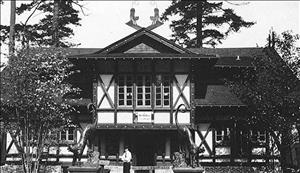On July 12, 1909, the National Lumber Manufacturers Association (a federation of associations representing the forest and building products industries) convenes at the Hoo-Hoo House at the Alaska-Yukon-Pacific Exposition for its annual convention. The delegates hear a speech touting the importance of conservation and reforestation, and approve a resolution declaring that odd as well as even lengths of lumber shall be the standard in the manufacture of all lumber used for building materials. The convention attracts approximately 600 powerful and affluent attendees from all over the United States.
Lumber and Conservation
The National Lumber Manufacturers Association was a federation of regional associations, formed in 1902 to provide a national association to represent the forest and building products industries. By 1909 it had grown to include a dozen regional associations representing some of the most powerful lumber manufacturers in the country. The association had some common membership with another national lumber association, the American Paper Institute, which represented pulp, paper, and paperboard manufacturers.
The seventh annual convention of the National Lumber Manufacturer’s Association convened at the Hoo-Hoo House on the morning of July 12, 1909, and the attendees were welcomed by A-Y-P president J. E. Chilberg (1867-1954) and Seattle mayor John Miller. The remainder of the day’s meeting was devoted to officer reports, and to a speech by R. S. Kellogg of the U.S. Forest Service. Kellogg cited statistics showing that total lumber production in the United States had declined 17 percent between 1907 and 1908, and noted that “lumbermen have for years destroyed, but not produced” (
The Seattle Daily Times,
July 12, 1909). Pointing out that overconsumption of forests was becoming a serious danger, Kellogg told the gathering that the time had come for conservation and reforestation.
Kellogg’s speech was among the early calls for lumber conservation and reforestation in the United States, but it would be some time before this translated into action. By the early 1920s some foresters were predicting that the American supply of mature timber would disappear by the end of the twentieth century if no action was taken. During the 1920s and 1930s Washington state took some steps toward reforestation, but it was the 1940s when the first large-scale efforts took place in the state. In 1941 the Weyerhaeuser Timber Company dedicated the 130,000-acre Clemons Tree Farm, the nation’s first, in Montesano (Grays Harbor County); this was followed by the enactment of Washington state’s first forest-practices act in 1946, which required loggers and landowners to replace trees they cut down.
Odd Lengths
The 600 or so visiting delegates and other lumbermen received a unique convention program. The eight-page document was printed on sheets of cedar; its pages were bound together with strips of leather to make a small book. The book came in handy, because the third day of the gathering featured a reading of no less than nine papers (presumably related to lumber issues) in the Fine Arts Building.
But it was the second day of the convention that brought big bucks to the affair. Observers estimated that the collective wealth of those attending the morning session at the Hoo-Hoo House was a quarter of a billion dollars, equating to between $4 and $5 billion in today’s (2008) dollars -- “probably the wealthiest gathering in Seattle on record,” reported The Seattle Daily Times.
The day’s business featured the approval of a resolution declaring that odd as well as even lengths of lumber would be the standard in the manufacture of flooring, ceiling, siding, and other building materials; as a result the meeting became informally known by some as the “odd lengths” conference. The meeting then adjourned early so delegates could go to Tacoma to attend the funeral of U.S. Congressman Francis Cushman (1867-1909). That evening the lumbermen held a reception and dance in the Washington State Building, attended by various political and lumber dignitaries.
In 1965 the National Lumber Manufacturers Association was renamed the National Forest Products Association. In 1993 the American Forest and Paper Association was formed to represent the interests of both the National Forest Products Association and the American Paper Institute in one national trade association on behalf of the U.S. forest products industry.

